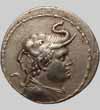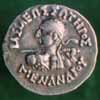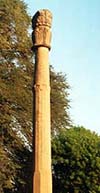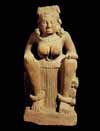|
|
 |
==Demetrios
and the "Indo-Greek kingdom" (c.180
BCE - 10 CE): Demetrios (r. c.190-170 BCE), one of the kings of the *Greco-Bactrian*
dynasty, establishes an extensive empire known as the *"Indo-Greek
kingdom"* in the Punjab and the Indus Valley. Many of these kings'
coins have inscriptions in Greek on one side, and the early Indian
Kharoshthi
(*ancient
scripts*) script on the other. [*Routes*] |
 |
==Menander/Milinda:
King Menander, or Milinda (c.150-130 BCE), is one of these Indo-Greek
rulers;
he begins his career as one of Demetrios's generals. He rules from
Shakala
(Sialkot?). According to Buddhist tradition, he asks Nagasena the
famous
"Questions of King Milinda" (*sacred
texts*; *U.
Miami*) and then converts to Buddhism. [*Routes*] |
 |
==the
Kushan dynasty in Gandhara (c.135 BCE - 200's CE) takes
power,
moving in from the northwest; it eventually comes to have twin capitals
at Peshawar and Mathura (*Met
Museum*). During this period Indo-Greek and Kushan dynastic
struggles
in the Punjab are so complex that numismatic evidence reveals the
presence
of more than thirty rulers in the course of less than two centuries: *the
age of the Kushans*. |
 |
==the
Shunga dynasty (c.100's BCE - 000's CE) becomes the
regional
successor to the Mauryas in the northeast: *Met
Museum*. [*Routes*] |
 |
==the
Pillar of Heliodorus (113 CE): The Greek Heliodorus
comes
to India as an envoy from the Indo-Greek king Antialkides, who rules in
Gandhara. Living in Besnagar (near Sanchi, Madhya Pradesh), Heliodorus
becomes a follower of the local proto-Vaishnavite cult of Vasudeva. In
the year 113 he dedicates a sixteen-sided stone column to Vasudeva. By
now the "Pillar of Heliodorus" has lost its original crown-- which was
a statue of Garuda, the bird on whom Vishnu rides. The inscription
around
its base is in a Prakrit, in the Brahmi script. Images: *art
and archaeology*; *Bullen*. |
 |
==Sanchi
(200's-100's
and onward): The superb Buddhist stupas and gates at Sanchi, in Madhya
Pradesh, begin to be built, though much of the greatest sculpture dates
from the 200 CE period. Sanchi's pillars, chakras ("wheels"), and
animal
capitals are very Ashokan; it also has a tremendous flow of illustrated
narratives ("jatakas," *IGNCA*)
about the Buddha's life. We are lucky to have a huge image archive: *Berger*;
*AIIS
Penn*; *DSAL*;
*Project
South Asia*. Discussion: *art
and archaeology*; *IndiaNest*.
[*Routes*] |
 |
==An
unknown goddess (c.200's-100's BCE): Even if we don't
know
who she is, she's a remarkably commanding figure. The gallery has
provided
a discussion of her probable origins; it's a good illustration of how
such
wonderful pieces are studied and dated. [*Routes*] |








